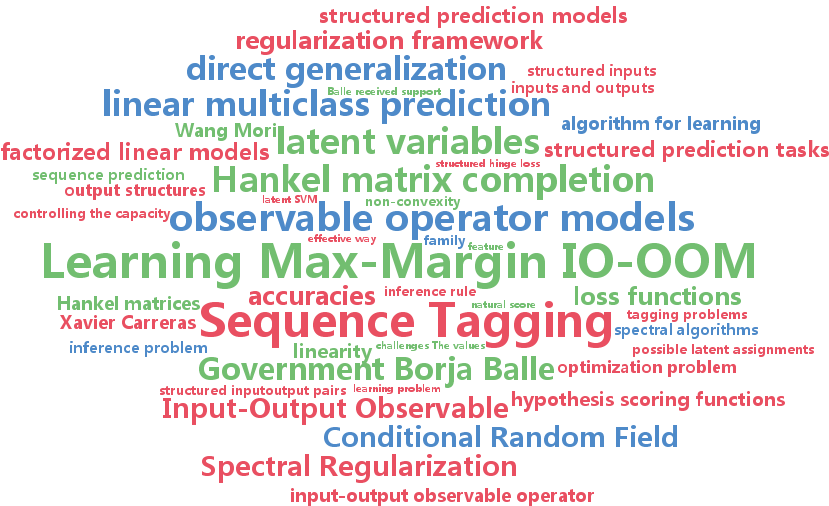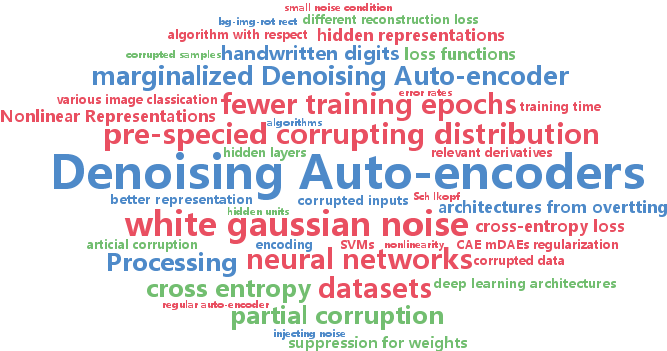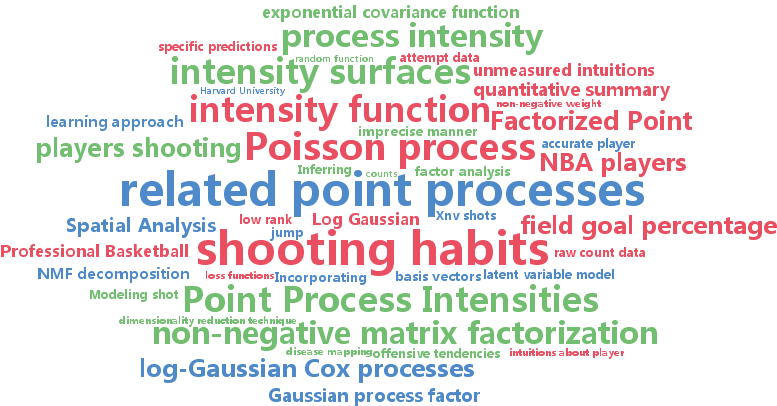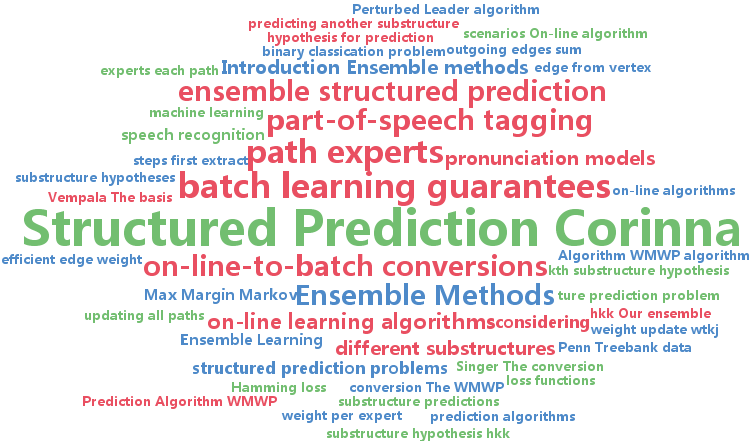loss functions
-
Feiping Nie and Jianjun Yuan and Heng Huang
Optimal Mean Robust Principal Component Analysis (pdf)
Dimensionality reduction techniques extract low-dimensional structure from high-dimensional data and are widespread in machine learning research. In practice, due to lacking labeled data, the unsupervised dimensionality reduction algorithms are more desired. Among them, Principal Component Analysis (PCA) is the most widely used approach. In recent research, several robust PCA algorithms were presented to enhance the robustness of PCA model. However, all existing robust PCA methods incorrectly center the data using the L2-norm distance to calculate the mean, which actually is not the optimal mean due to the L1-norm used in the objective functions. It is non-trivial to remove the optimal mean in the robust PCA, because of the sparsity-inducing norms used in the robust formulations. In this paper, we propose novel robust PCA objective functions with removing optimal mean automatically. We naturally integrate the mean calculation into the dimensionality reduction optimization, such that the optimal mean can be obtained to enhance the dimensionality reduction. Both theoretical analysis and empirical studies demonstrate our new methods can more effectively reduce data dimensionality than previous robust PCA methods.
-
Ariadna Quattoni and Borja Balle and Xavier Carreras and Amir Globerson
Spectral Regularization for Max-Margin Sequence Tagging (pdf)
We frame max-margin learning of latent variable structured prediction models as a convex optimization problem, making use of scoring functions computed by input-output observable operator models. This learning problem can be expressed as an optimization involving a low-rank Hankel matrix that represents the input-output operator model. The direct outcome of our work is a new spectral regularization method for max-margin structured prediction. Our experiments confirm that our proposed regularization framework leads to an effective way of controlling the capacity of structured prediction models.
-
Minmin Chen and Kilian Weinberger and Fei Sha and Yoshua Bengio
Marginalized Denoising Auto-encoders for Nonlinear Representations (pdf)
Denoising auto-encoders (DAEs) have been successfully used to learn new representations for a wide range of machine learning tasks. During training, DAEs make many passes over the training dataset and reconstruct it from partial corruption generated from a pre-specified corrupting distribution. This process learns robust representation, though at the expense of requiring many training epochs, in which the data is explicitly corrupted. In this paper we present the marginalized Denoising Auto-encoder (mDAE), which (approximately) marginalizes out the corruption during training. Effectively, the mDAE takes into account infinitely many corrupted copies of the training data in every epoch, and therefore is able to match or outperform the DAE with much fewer training epochs. We analyze our proposed algorithm and show that it can be understood as a classic auto-encoder with a special form of regularization. In empirical evaluations we show that it attains 1-2 order-of-magnitude speedup in training time over other competing approaches.
-
Taiji Suzuki
Stochastic Dual Coordinate Ascent with Alternating Direction Method of Multipliers (pdf)
We propose a new stochastic dual coordinate ascent technique that can be applied to a wide range of regularized learning problems. Our method is based on alternating direction method of multipliers (ADMM) to deal with complex regularization functions such as structured regularizations. Although the original ADMM is a batch method, the proposed method offers a stochastic update rule where each iteration requires only one or few sample observations. Moreover, our method can naturally afford mini-batch update and it gives speed up of convergence. We show that, under mild assumptions, our method converges exponentially. The numerical experiments show that our method actually performs efficiently.
-
Andrew Miller and Luke Bornn and Ryan Adams and Kirk Goldsberry
Factorized Point Process Intensities: A Spatial Analysis of Professional Basketball (pdf)
We develop a machine learning approach to represent and analyze the underlying spatial structure that governs shot selection among professional basketball players in the NBA. Typically, NBA players are discussed and compared in an heuristic, imprecise manner that relies on unmeasured intuitions about player behavior. This makes it difficult to draw comparisons between players and make accurate player specific predictions. Modeling shot attempt data as a point process, we create a low dimensional representation of offensive player types in the NBA. Using non-negative matrix factorization (NMF), an unsupervised dimensionality reduction technique, we show that a low-rank spatial decomposition summarizes the shooting habits of NBA players. The spatial representations discovered by the algorithm correspond to intuitive descriptions of NBA player types, and can be used to model other spatial effects, such as shooting accuracy.
-
CORINNA CORTES and Vitaly Kuznetsov and Mehryar Mohri
Ensemble Methods for Structured Prediction (pdf)
We present a series of learning algorithms and theoretical guarantees for designing accurate ensembles of structured prediction tasks. This includes several randomized and deterministic algorithms devised by converting on-line learning algorithms to batch ones, and a boosting-style algorithm applicable in the context of structured prediction with a large number of labels. We give a detailed study of all these algorithms, including the description of new on-line-to-batch conversions and learning guarantees. We also report the results of extensive experiments with these algorithms in several structured prediction tasks.
-
Francesco Orabona and Tamir Hazan and Anand Sarwate and Tommi Jaakkola
On Measure Concentration of Random Maximum A-Posteriori Perturbations (pdf)
The maximum a-posteriori (MAP) perturbation framework has emerged as a useful approach for inference and learning in high dimensional complex models. By maximizing a randomly perturbed potential function, MAP perturbations generate unbiased samples from the Gibbs distribution. Unfortunately, the computational cost of generating so many high-dimensional random variables can be prohibitive. More efficient algorithms use sequential sampling strategies based on the expected value of low dimensional MAP perturbations. This paper develops new measure concentration inequalities that bound the number of samples needed to estimate such expected values. Applying the general result to MAP perturbations can yield a more efficient algorithm to approximate sampling from the Gibbs distribution. The measure concentration result is of general interest and may be applicable to other areas involving Monte Carlo estimation of expectations.
-
Qinxun Bai and Henry Lam and Stan Sclaroff
A Bayesian Framework for Online Classifier Ensemble (pdf)
We propose a Bayesian framework for recursively estimating the classifier weights in online learning of a classifier ensemble. In contrast with past methods, such as stochastic gradient descent or online boosting, our framework estimates the weights in terms of evolving posterior distributions. For a specified class of loss functions, we show that it is possible to formulate a suitably defined likelihood function and hence use the posterior distribution as an approximation to the global empirical loss minimizer. If the stream of training data is sampled from a stationary process, we can also show that our framework admits a superior rate of convergence to the expected loss minimizer than is possible with standard stochastic gradient descent. In experiments with real-world datasets, our formulation often performs better than online boosting algorithms.
-
Yujia Li and Rich Zemel
High Order Regularization for Semi-Supervised Learning of Structured Output Problems (pdf)
Semi-supervised learning, which uses unlabeled data to help learn a discriminative model, is especially important for structured output problems, as considerably more effort is needed to label its multidimensional outputs versus standard single output problems. We propose a new max-margin framework for semi-supervised structured output learning, that allows the use of powerful discrete optimization algorithms and high order regularizers defined directly on model predictions for the unlabeled examples. We show that our framework is closely related to Posterior Regularization, and the two frameworks optimize special cases of the same objective. The new framework is instantiated on two image segmentation tasks, using both a graph regularizer and a cardinality regularizer. Experiments also demonstrate that this framework can utilize unlabeled data from a different source than the labeled data to significantly improve performance while saving labeling effort.








